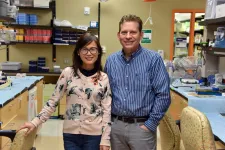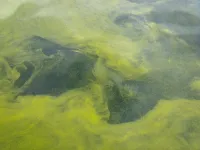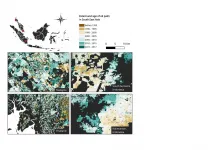Beetle outbreak impacts vary across Colorado forests
2021-03-30
(Press-News.org) It's no secret. Colorado's forests have had a tough time in recent years. While natural disturbances such as insect outbreaks and wildfires occurred historically and maintained forest health over time, multiple, simultaneous insect disturbances in the greater region over the past two decades have led to rapid changes in the state's forests.
A bird's eye view can reveal much about these changes. Annual aerial surveys conducted by the Colorado State Forest Service and USDA Forest Service have provided yearly snapshots for the state. New collaborative research led by Colorado State University and the University of Wisconsin-Madison now supplements this understanding with even greater spatial detail.
The study, "Effects of Bark Beetle Outbreaks on Forest Landscape Pattern in the Southern Rocky Mountains, U.S.A.," analyzed Landsat satellite imagery between 1997-2019 to quantify how outbreaks of three different insect species have impacted forests across high-elevation forests in Colorado, southern Wyoming, and northern New Mexico. The research team found that while these collective beetle outbreaks impacted around 40 percent of the area studied, the effects of these outbreak varied due to differences in forest structures and species composition across the region.
"In contrast to research that has examined the heterogeneous effects of wildfire on trees, there hasn't been much work on the landscape-level variation in bark beetle effects on forests, particularly across broad areas," said Sarah Hart, co-author and assistant professor in the Forest and Rangeland Stewardship department. "Heterogeneity plays an important role in how these forests will look in the future, where surviving trees will regenerate the forest, and what potential there is for future outbreaks."
Their results indicate that most forest stands affected by insects still have mature trees that can be sources for reestablishing seeds and conditions for the next generation of trees to grow. Areas with tree mortality greater than 90 percent were relatively small and isolated. Unlike severe wildfires that can kill all trees in its path, trees typically survive bark beetle outbreaks, facilitating forest recovery in upcoming decades.
High-resolution, field-level accuracy
Widespread outbreaks of three important bark beetle species have occurred in Colorado's forests since the turn of the century: mountain pine beetle, spruce beetle, and the western balsam beetle (that affects various fir tree species). These bark beetles primarily target large trees with reduced defenses due to lower precipitation amounts and higher temperature trends since the turn of the century.
This research team combined satellite imagery capable of identifying small groups of dead trees with a decade of extensive field data from nearly 250 plots to develop presence and severity maps for tree mortality caused by bark beetle attacks. Having this data combination gave the research team detailed information about how many trees have died in particular places, and helped to identify what may still be causing the death of individual trees.
"These maps give us unique insight into the effects of recent insect outbreaks because they span a large area but also show a lot of detail, and we are confident that they are showing us how many trees are dying because technicians counted trees on the ground," Kyle Rodman, lead author and post-doctoral researcher at the University of Wisconsin-Madison said.
The maps the team produced indicate that areas most impacted by bark beetles are concentrated in northern and southwestern Colorado due to higher concentrations of old lodgepole pine and spruce forests which were then infested by mountain pine beetle and spruce beetle, respectively. Western balsam beetle impacts were also widespread across the region, but these beetles tended to kill fewer trees in any single location.
"Satellite data is a crucial bridge that allows us to take detailed information from individual places and extend this localized knowledge to large areas," Rodman said. "In using these maps, we can see how the forest has changed over the past 20 years during each of these outbreaks."
Fortunately, much of the 25,000 square kilometer study area showed low to moderate levels of tree mortality, with high tree mortality being contained in small and isolated patches averaging only about nine city blocks in overall size.
"People tend to notice what has changed, rather than what has stayed the same," Rodman said. "These forests have changed a lot, but I am hopeful. It will just take a little while for them to recover, but many of these beetle-killed forests are likely to recover within a few decades."
INFORMATION:
[Attachments] See images for this press release:

ELSE PRESS RELEASES FROM THIS DATE:
2021-03-30
A growing number of young people are identifying as part of the LGBTQ+ community, and many are challenging binaries in gender and sexual identity to reflect a broader spectrum of experience beyond man or woman and gay or straight. But not everyone is participating equally in these diverse forms of expression, according to new research from the University of California, Santa Cruz.
Psychology Professor Phillip Hammack's latest paper, published in the Journal of Adolescent Research, is shedding light on the social factors that can either hinder or support expression of diversity in sexual and gender identity ...
2021-03-30
The study, published in Nature Geoscience, produced a global model mapping pollution risk caused by 92 chemicals commonly used in agricultural pesticides in 168 countries.
The study examined risk to soil, the atmosphere, and surface and ground water.
The map also revealed Asia houses the largest land areas at high risk of pollution, with China, Japan, Malaysia, and the Philippines at highest risk. Some of these areas are considered "food bowl" nations, feeding a large portion of the world's population.
University of Sydney Research Associate and the study's lead author, Dr Fiona Tang, said the widespread use of pesticides in agriculture - while boosting productivity - could have potential implications for the environment, human and animal ...
2021-03-30
The latest gene editing technology, prime editing, expands the "genetic toolbox" for more precisely creating disease models and correcting genetic problems, scientists say.
In only the second published study of prime editing's use in a mouse model, Medical College of Georgia scientists report prime editing and traditional CRISPR both successfully shut down a gene involved in the differentiation of smooth muscle cells, which help give strength and movement to organs and blood vessels.
However, prime editing snips only a single strand of the double-stranded DNA. CRISPR makes double-strand cuts, which can be lethal to cells, and produces unintended edits at both the work site as well as randomly across the genome, ...
2021-03-30
HANOVER, N.H. - March 30, 2021 - Cyanobacteria living at the bottom of lakes may hold important, under-researched clues about the threat posed by these harmful organisms, according to a Dartmouth-led study.
The research, published in the Journal of Plankton Research, urges a more comprehensive approach to cyanobacteria studies in order to manage the dangerous blooms during a time of global climate change.
"Most studies of cyanobacteria focus on the times when they are visible in the water column," said Kathryn Cottingham, the Dartmouth Professor in the Arts and ...
2021-03-30
As our planet warms, seas rise and catastrophic weather events become more frequent, action on climate change has never been more important. But how do you convince people who still don't believe that humans contribute to the warming climate?
New UBC research may offer some insight, examining biases towards climate information and offering tools to overcome these and communicate climate change more effectively.
Researchers examined 44 studies conducted over the past five years on the attentional and perceptual biases of climate change - the tendency to pay special attention to or perceive particular aspects of climate change. They identified a number of ...
2021-03-30
UNIVERSITY PARK, Pa. -- A reproducibility crisis is ongoing in scientific research, where many studies may be difficult or impossible to replicate and thereby validate, especially when the study involves a very large sample size. For example, to evaluate the validity of a high-throughput genetic study's findings scientists must be able to replicate the study and achieve the same results. Now researchers at Penn State and the University of Minnesota have developed a statistical tool that can accurately estimate the replicability of a study, thus eliminating the need to duplicate the work and effectively ...
2021-03-30
In a joint effort, researchers from the Humboldt-Universität (Berlin), the Max Born Institute (Berlin) and the University of Central Florida (USA), have revealed the necessary conditions for the robust transport of entangled states of two-photon light in photonic topological insulators, paving the way the towards noise-resistant transport of quantum information. The results have appeared in Nature Communications.
Originally discovered in condensed matter systems, topological insulators are two-dimensional materials that support scattering-free (uni-directional) transport along their edges, even in the presence of defects and disorder. In ...
2021-03-30
IIASA researchers have used Sentinel 1 satellite imagery from the European Space Agency to produce a map of the extent and year of detection of oil palm plantations in Indonesia, Malaysia, and Thailand that will help policymakers and other stakeholders understand trends in oil palm expansion while also providing an accurate map for landscape-level planning.
The world's appetite for palm oil seems to know no bounds. We use it in everything from beauty products and food, to industrial processes and biofuels to fulfill our energy needs. This ever growing demand has caused oil palm production to more than double in the last two decades, a development which has in turn deeply impacted natural forest ecosystems and biodiversity, while also significantly ...
2021-03-30
One in four Germans suffers from metabolic syndrome. Several of four diseases of affluence occur at the same time in this 'deadly quartet': obesity, high blood pressure, lipid metabolism disorder and diabetes mellitus. Each of these is a risk factor for severe cardiovascular conditions, such as heart attack and stroke. Treatment aims to help patients lose weight and normalise their lipid and carbohydrate metabolism and blood pressure. In addition to exercise, doctors prescribe a low-calorie and healthy diet. Medication is often also required. However, it is not fully clear ...
2021-03-30
Researchers at KU Leuven (Belgium) have succeeded for the first time in measuring brain waves directly via a cochlear implant. These brainwaves indicate in an objective way how good or bad a person's hearing is. The research results are important for the further development of smart hearing aids.
A cochlear implant enables people with severe hearing loss to hear again. An audiologist adjusts the device based on the user's input, but this is not always easy. Think of children who are born deaf or elderly people with dementia. They have more difficulty assessing and communicating ...
LAST 30 PRESS RELEASES:
[Press-News.org] Beetle outbreak impacts vary across Colorado forests





